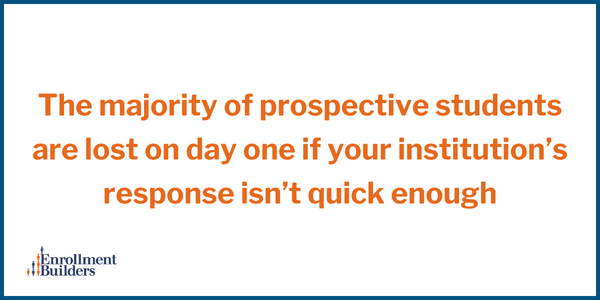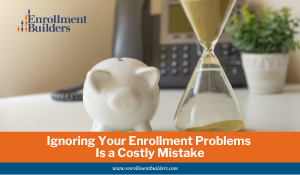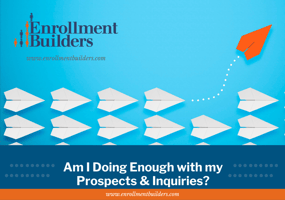Updated 10/23/2023 You’re working hard to lift enrollment numbers. You’ve identified the problems...
How to Increase Admissions Conversion Rates with Proven Contact Cadence Strategies
Are you concerned that your current contact strategies are letting potential students slip through the cracks? Is your admissions team making data-driven decisions to improve outreach or do you feel unable to challenge the status quo?
At Enrollment Builders, we use proven contact cadence strategies through a combination of mediums to qualify prospective students for admissions teams so they can focus on having more valuable conversations with interested students.
Implementing contact cadences is an excellent way to build better relationships and convert more prospective students. But what exactly is a contact cadence, and how do you begin to try this strategy?
In this article, you’ll discover:
- What an admissions contact cadence is
- Benefits of using contact cadences in your admissions strategy
- How to build your strategy to engage prospective students
- Challenges admissions teams face when implementing contact cadences
After reading, you’ll understand how you can improve contact cadences within your process to increase student enrollment rates.
What Is an Admissions Contact Cadence?
A contact cadence is defined as the systematic sequence of engagements or follow-ups used by an admissions representative or team to engage with prospective students.
A contact cadence helps guide your admissions representatives by creating a predictable and consistent series of actions to perform for each major step in the admissions process.
The most common types of contact cadences within an admissions strategy are:
- Attempting Cadences establish contact with prospective students so they can be qualified. This allows the institution to start developing a relationship with prospects, inquiries, and stealth applicants.
- Follow-up Cadences nudge prospective students to apply, complete their FAFSA, collect official transcripts, attend orientation, schedule classes, and more.
- Transition Cadences move the student along the admissions funnel as their relationship with the team matures. During this time, they will meet with various subject matter experts, such as the financial aid team, recruiters, advisors, student success, and faculty.
While all of these cadences are beneficial, the most successful admissions teams maximize their time and resources by focusing on an Attempting Cadence within the first 5 minutes of a new inquiry being generated.
That’s because the majority of prospective students are lost on day one if contact isn’t initiated quickly enough. If your team is slower to respond than other institutions the student is considering, you’ve likely lost the chance to earn their enrollment.

Benefits of Using Contact Cadences as Part of Your Higher Ed Admissions Strategy
Institutions that implement contact cadences within their strategic enrollment management plan see several benefits. The most common benefits are:
- Structured Frameworks for Effectiveness - With a contact cadence strategy, the plan and process remain the same no matter what. This is crucial to keep your team working effectively, whether you have staff turnover or bring someone new onto your team.
- Consistent Student Experiences - Using a framework and documented process ensures every prospective student receives the same experience, no matter who contacts them. Plus, with a properly implemented contact cadence, no interested students will get left behind.
- Connect with Students on Their Terms - It can be difficult to reach nontraditional learners who have work and personal commitments during “traditional” hours. Communicating consistently through multiple channels (text, call, and email) is a better way to nurture prospective students through the admissions process to enrollment.
- Data-Driven Decisions & Accountability - With a system in place and the right technology to track it, you can hold everyone accountable for doing the right work. You can also implement a feedback loop to easily identify opportunities for improvement within your admissions strategy.
- Effective Resource Allocation - With data tracking, you can share reports with your marketing team so they know where to double down to generate the right blend of quality and quantity. No more investing in bad lead sources!
To learn more about contact cadences and discover why other institutions use them, read: How Implementing Contact Cadences Improves Appointment Attendance Rates
How to Build Your Contact Cadence Strategy to Engage Prospective Students
In our experience developing contact cadences for higher education institutions, we’ve identified 7 key steps to create an effective strategy:
- Choose a Segment - Every contact cadence should have a focused segment based on looking at a group of prospective students with a similar need. For example, a segment may include prospects who completed an info request form indicating they want to enroll in the next semester. The type of contact cadence you build will depend on your target segment.
- Determine the Goal - Identify what a “successful contact” looks like. This is the goal your team has for implementing the contact cadence. When the goal is met, the prospective student will no longer need to receive messaging within the cadence.
- Identify Contact Mediums - For the highest chance of success, your strategy should include multiple contact methods. The most common mediums are phone, SMS, voicemail, website chat, and email. Combining these mediums helps to maximize student engagement with your institution.
- Choose the Duration of the Cadence - Discuss how many times you will attempt to reach out and how many days the cadence will last. Our data shows that it takes seven attempts on average to get a prospective student to respond and engage with admissions teams.
- Determine Contact Frequency and Timing - Many of your prospective students work or have personal obligations during the week. We recommend planning for some of your staff to be available on evenings and weekends to connect with students at the time that’s most convenient for them.
- Develop Messaging - Document the messaging for each step in the process to make it as simple as possible for your team to execute.
- Build Processes and Tracking Systems - Be sure to document the process so your team can be effective and efficient as they get started with your new strategy. In addition, implementing a system where your team can track the progress of each prospect is crucial for a smooth student experience and identifying future opportunities for improvement.
Challenges Admissions Teams Face When Trying to Implement Contact Cadences
While using contact cadences to engage prospective students is an excellent strategy, there are some challenges you may face. The most common challenges are:
- Bandwidth Issues - If your team already has challenges contacting every prospective student, or if you’ve had significant staff turnover, implementing this strategy on your own could prove difficult.
- Staffing Hours - If your admissions staff only works during traditional daytime hours, you may need to find other ways to be available to prospective students during nights and weekends.
- Push Back Against Cold-Calling - Most admissions staff don’t want to “cold call” because it feels like a waste of their time, skills, and knowledge. They want to focus on valuable, relationship-building conversations - not qualifying every prospective student handed over from marketing.
- Outdated Technology - Some admissions teams don’t have the technology needed to use SMS messaging. If your students receive text messages from a different phone number than you call them from, it can cause confusion and uncertainty.
- Lack of Data Structure & Accountability - If you don’t have the proper data model implemented in your CRM, it’s difficult to ensure leads are worked consistently every time. This makes it difficult to maintain accountability and have effective performance management.
By knowing the potential challenges, you can be more prepared and better plan ahead as you incorporate contact cadences into your admissions strategy.
Explore Partnership Opportunities for Admissions Success
Now that you understand the benefits of contact cadences, strategies to implement them, and potential challenges that may come up, you may be feeling a bit overwhelmed.
When your admissions team is already spread thin, finding the bandwidth to implement a new enrollment management strategy can feel impossible. You’re not alone.
When facing these challenges, admissions leaders like you often consider outsourcing part of the admissions process so their team can focus on building relationships with the most qualified prospective students.
If you need immediate improvements to your outreach, consider working with a higher education contact center.
A higher education contact center will have established contact cadence strategies that you can have up and running in a matter of weeks - without putting strain on your internal team.
To discover if partnering with a higher education contact center is the right solution for you, read the article:



